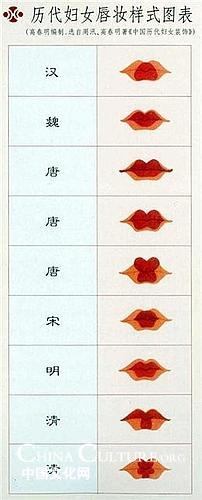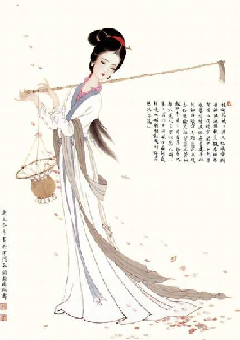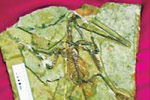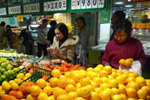Center
Chinese makeup for lips
Updated: 2009-06-18 11:49
By Wen Yi (chinaculture.org)
The early lip balm was not like the lipstick we see today, but was a paste held in a particular container. After Sui (AD 589 — AD 618) and Tang Dynasties, some lip balm was processed into solid substance, tubular in shape. Being handy, this new type soon gained popularity. The production of lip balm has not undergone great renovation only until modern times.
The lip balm in ancient China also bore fantastic fragrance. In the North Dynasty (AD 386—AD 581) raw materials included ageratum and clove. In the Tang Dynasty, artificial flavors were added to the lip balm.
Various Patterns of Lip Makeup in Chinese History
 |
|
Patterns of Lip Makeup in Different Dynasties Mentioned Below |
Between Pre-Qin ( The 21st Century BC—221 BC) and Han (202BC-220AD) Dynasties, instead of applying lip balm to all parts of the lips, women put a big red dot on the lower lip and painted the upper lip in a pointed shape, leaving the rest of parts to be covered with powder.
In Wei, Jin, and North and South Dynasties (AD220—AD589), fan-shaped lips were advocated. Women made an obvious depression on the upper lip and lip contour in the corners of the mouth clear.
In Sui and Tang Dynasties, a florid style of lip makeup gained popularity. Women first put powder onto the lips, and then they drew any pattern they liked. During that period, cherry lips (lips with the shape and color of a cherry) were very popular. Two dots were usually painted outside the corner of the lips to strengthen the image of dimples. Another famous pattern took the shape of a little flower. To make it, women first made an obvious depression in the middle of the upper lip. Then the upper lip contour took the shape of two petals, and the lower lip another petal.
In the late Tang Dynasty, other patterns for lip makeup were also invented. According to the book Records of the Unworldly and the Strange, there were 17 patterns in the last 30 years of Tang. The color of red for lips included red, light red, red with golden powder, pink and so on.
In the Song (AD960—AD1279) and Ming (AD1368—AD1644) Dynasties, lip makeup was practiced to make women look more internalized and gentle. Cherry lips were also highly welcomed.
In the Qing Dynasty (AD1644—AD1911), women normally applied rouge to the whole or nearly whole upper lip, while they painted a cherry-like dot in the middle of the lower lip. Some women dotted in the middle of the two lips respectively.
In late Qing Dynasty, the whole society regarded Lin Daiyu as the beauty icon, who is a household character in the Chinese novel Dream of the Red Chamber, beautiful but fragile emotionally and physically. This fancy for morbid beauty lasted for a while till the period of the Republic of China.
 |
|
Lin Daiyu |
Although both ancient and contemporary Chinese women mainly employed red for the lips, there is a black “tear makeup” which gained popularity in the Yuanhe years of the Tang Dynasty (AD806—AD820). Black balm was applied to the lips, producing a seemingly crying sad face. Failing to satisfy aesthetic sensibilities of many people, this tear makeup went out of fashion shortly after.
To express their sentimental attachment and pout to the men, some women left their lip marks with different shapes, colors and fragrances on men’s necks and clothes, making the meeting some time ago unforgettable. This activity was mentioned in many Chinese ancient poems.
Specials

President Hu visits the US
President Hu Jintao is on a state visit to the US from Jan 18 to 21.

Ancient life
The discovery of the fossile of a female pterosaur nicknamed as Mrs T and her un-laid egg are shedding new light on ancient mysteries.

Economic Figures
China's GDP growth jumped 10.3 percent year-on-year in 2010, boosted by a faster-than-expected 9.8 percent expansion in the fourth quarter.